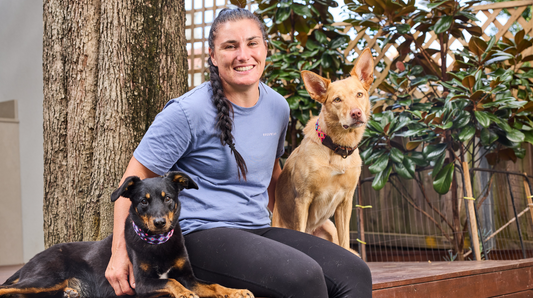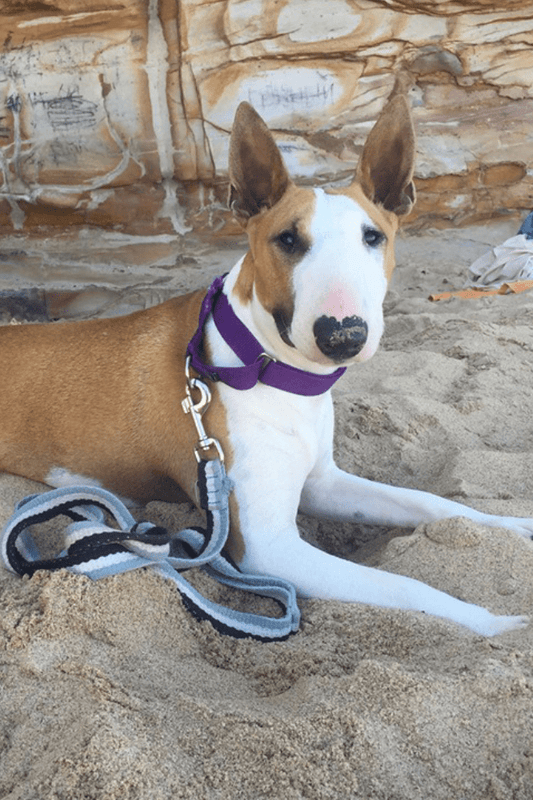Spring getting under your dog’s skin? Understanding skin health, itching, allergies and canine atopic dermatitis in spring.
There is nothing more irritating for your dog than a constant itch. As an owner, watching your dog literally tear their skin apart in a futile attempt to soothe the itch is heartbreaking. They’re red raw, they're causing bald patches, and they may even be bleeding.
For some dogs, these itchy skin conditions are manageable most of the year, but come spring, with the increasing temperatures and high pollen count, there is just no getting over the itch.
Understanding what causes your dog’s allergic skin disease, and how to manage it will help them to live a happy, more comfortable life.
Skin 101 - Healthy skin
Your dog’s skin is their first defence against the outside world, so keeping it strong and healthy is vital to their long-term health and wellbeing. But what makes up their skin when it’s at its best?
Your dog’s skin layers

The Subcutis
This is the deepest layer of the skin. The subcutis contains subcutaneous fat and muscle. It provides insulation, is a shock absorber and a store for fluids, energy and electrolytes.
The Dermis
The middle layer provides structural support and nourishment to the outer layer and skin appendages (like hair).
The dermis contains blood vessels which supply the outer layer and are important in your dog's temperature regulation. The dermis is also where the skin’s nerves are located, responding to sensations such as pain, heat, cold, and discomfort from irritations.
Hair follicles also start growing in this layer and exit via pores in the outer dermal later.
The Epidermis
The outer layer, the bit you can see, is known as the epidermis. This is your dog’s first defence against the outside world. It prevents foreign substances from entering the body, and it helps to prevent water loss.
The epidermis is made up of multiple cell types, each with its own function. They produce pigmentation for the skin and hair, contribute to the immune system, provide sensory information (for example, from whiskers) and produce new skin cells.
The rate at which skin cells are shed and replaced can be affected by nutrition, disease, hormones, immune responses, inflammation and genetics, as well as other factors like medication.
What Is Allergic Skin Disease In Dogs?
Allergic skin disease or Atopic Dermatitis is an inflammatory skin condition causing itching, scratching, redness and inflammation. Dogs are often genetically predisposed to it, but this is not always the case. At least 10% of dogs are affected by it, and in Australia, we see it more commonly than in other countries, thanks to our hot climate.
Normal skin cells are like a wall. The cells are tightly packed together like bricks, with strong mortar between them. Skin with seasonal skin disease is more like a dry stone wall. The cells aren’t so tightly packed together, and the cement isn't strong. Water is able to pass out of the skin; it’s dry and crumbly, but it also allows allergens through from the outside, resulting in immune responses.

Causes Of Your Dog’s Atopic Dermatitis
Many people think allergic skin disease is caused by food allergies. But actually, most of the time, food isn’t the problem. Over 90% of allergies are caused by something environmental. Only 10% have food as their root cause.
Seasonal allergic skin disease is an exaggerated response by the immune system, often in response to an external irritant or allergen, such as pollen.
Why Is Canine Allergic Skin Disease Worse In Spring?
Think of it like hay fever. It is most often caused by an overreaction of the immune system to an external factor. In spring there are way more potential irritants in your dog’s environment. Tree pollen, grass pollen, flowers, dust thrown up from cleaning or harvesting, or an increase in parasite numbers such as fleas. All of these things can potentially cause allergic reactions in your dog, making them itchy and uncomfortable.
Australian pollen calendar
It might be useful to know what pollens are around and when. The Australian Society of Clinical Immunology and Allergy have an annual calendar which shows what is active and when. It could be handy to know for your dog and even for you if you have hay fever.
Find the pollen calendar here.
Symptoms of seasonal skin disease in dogs
- Itching, scratching and chewing skin
- Redness
- Hair loss
- Discolouration of fur
- Dry, flaky skin
- Thickening of skin
- Weeping skin
- Sores
- Signs of infection.
Your dog’s itch-scratch cycle
The problem with skin disease is that it’s a self-perpetuating cycle. Itching damages the skin, which causes inflammation and infection, making your dog scratch more…causing more inflammation. To improve your dog’s condition, we need to break this cycle.
How To Treat Canine Atopic Dermatitis
Managing your dog’s skin condition requires a multi-modal approach—utilising multiple potential treatments, supplements, products or lifestyle changes, and this approach might need to change with the seasons.
Each treatment option has its pros and cons, and we recommend discussing your dog’s condition in detail with your vet. Here are some common treatments and supports for dogs with seasonal skin disease:
- Steroid treatment
- Non-steroidal anti-inflammatory drugs
- High-quality omega-3 skin supplements
- Immunotherapy
- Topical skin creams or shampoos
- Anti-histamine medication
Other ways you can help your dog to manage seasonal atopic dermatitis.
- Check the pollen count and close windows if the pollen count is high
- Invest in an air purifier. This will help you and your dog by removing allergens from the air in your house.
- Regularly wash bedding and toys to remove pollen and irritants
- Keep your dog’s flea treatments up to date to ensure they’re protected when flea numbers increase in spring.
- Support them nutritionally with a supplement like Antinol Plus.
How can Antinol Plus help with your dog’s allergic skin disease in spring?
Antinol Plus contains a highly potent blend of marine lipids and is commonly used to support skin health. It is a natural anti-inflammatory and works in a variety of ways to soothe skin and maintain health throughout the year, particularly in the spring.
Antinol supports your dog's skin health by:
- Improving the integrity of the skin barrier - strengthening the skin cell walls and preventing water loss.
- Providing a natural anti-inflammatory effect during flare-ups. This helps to break the itch cycle and reduce scratching and discomfort.
- Modulating the immune response. This enables your dog to cope better when faced with seasonal allergens.
- Promoting healthy skin, resulting in more comfortable, hydrated skin and a shiny coat.
Antinol and skin allergy medication
One of the problems with certain medications for skin conditions is that keeping your dog on a high dose for long periods of time isn’t appropriate, thanks to some unpleasant side effects. However, as you taper or reduce reliance on these medications, your dog is likely to experience a flare-up, or “rebound”, and you will see an increase in their uncomfortable skin symptom.
Antinol Plus can help here. If you’re ready to reduce your dog’s reliance on medication, studies have shown that Antinol can reduce the likelihood of rebound symptoms, enabling you to reduce your dog’s medication dosage without the uncomfortable side effects.
When should you start giving Antinol to your dog with seasonal atopic dermatitis?
Start ASAP! But especially in the lead-up to spring. Giving your dog the higher loading dose as we enter spring will support them during a time of year when you might see flare-ups.
Try Antinol for your dog with ASD this spring!
https://antinol.com.au/pages/60-day-risk-free-trial









